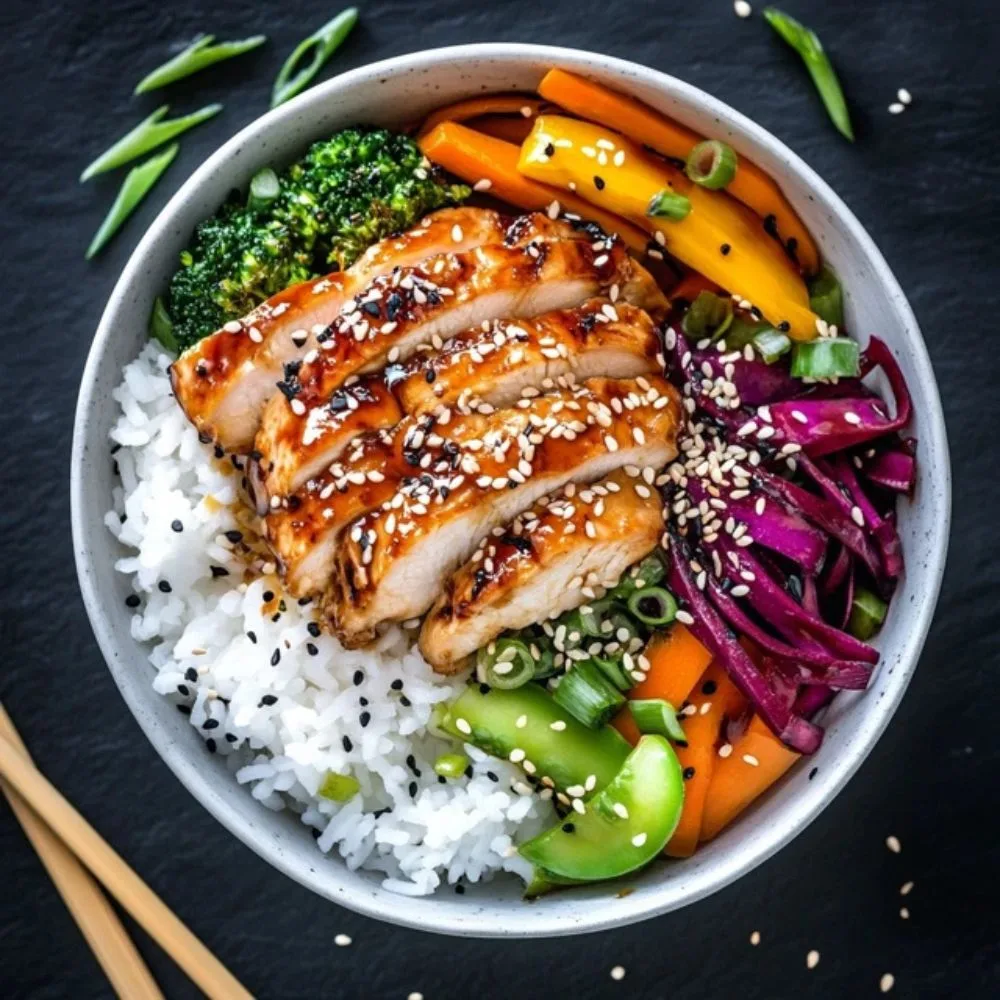There’s something mighty comforting about a Teriyaki Bowl. The tender meat, the glossy sauce, and the steamy bed of rice come together in a harmony of flavors. Folks down here in my Southern kitchen adore the sweet and savory taste, and it’s a simple meal that fits into busy days. So, I’m ready to share my favorite version of this Japanese-inspired dish that brings cheer to every table.
I reckon you’ll love learning how to whip up a Teriyaki Bowl in a snap. This recipe blends the goodness of fresh produce with a well-seasoned protein and a homemade teriyaki sauce. Yet, it never feels fussy. Instead, it invites you to enjoy a balanced, hearty meal that pleases all ages. And you can count on it to become one of those must-have dinners in your regular rotation.
Why You’ll Love This Teriyaki Bowl Recipe
Key Benefits of Making a Teriyaki Bowl
This Teriyaki Bowl is an excellent choice for a quick and satisfying meal, making it perfect for busy weeknights. It comes together effortlessly using pantry-friendly ingredients like soy sauce, garlic, and ginger, eliminating the need for last-minute grocery store runs. Despite its simplicity, this dish feels special enough to serve on more festive occasions or enjoy as a comforting everyday dinner. Each bite delivers a delightful balance of sweet and savory flavors, giving it that classic umami-rich teriyaki taste that so many people love.
- Quick and easy – Ready in minimal time, ideal for fast weeknight meals.
- Pantry-friendly – Uses common ingredients like soy sauce, garlic, and ginger.
- Versatile – Works for casual dinners or special occasions without extra effort.
- Delicious balance – A mix of sweet, salty, and savory flavors in every bite.
Additionally, this recipe accommodates a wide range of dietary preferences. You can make it gluten-free by swapping out traditional soy sauce for tamari or coconut aminos. For a vegetarian or vegan version, simply replace the meat with tofu, tempeh, or even extra vegetables like mushrooms and bell peppers. If you prefer a noodle-based dish, the teriyaki sauce pairs beautifully with ramen, soba, or rice noodles, making it adaptable to different cravings.
- Gluten-free option – Use tamari instead of regular soy sauce.
- Meatless option – Swap chicken or beef for tofu or tempeh.
- Adaptable – Works just as well over rice or noodles.
For those watching their sodium intake, using low-sodium soy sauce is a great way to reduce salt without compromising flavor.
Is This Teriyaki Bowl Recipe Right for You?
This recipe is perfect for beginners, as it requires no advanced cooking skills. Simply stir the sauce, sauté the ingredients, and assemble the bowl. Even those new to cooking can follow along without difficulty, while experienced cooks can personalize it by adding extra spice, different vegetables, or a protein of their choice.
- Beginner-friendly – Simple steps with no complicated techniques.
- Customizable – Easy to adjust by adding heat, extra veggies, or different proteins.
If you love quick and flavorful Asian-inspired meals, this dish is a fantastic choice. It’s also great for meal prep, as it can be doubled to feed a crowd or portioned into containers for easy lunches throughout the week. Leftovers store well in the fridge for a couple of days, allowing for a convenient heat-and-eat meal on busy days.
- Meal-prep friendly – Make extra for quick lunches and dinners.
- Lasts in the fridge – Keeps well for 2-3 days, making it a great make-ahead option.
Whether you need a fast dinner solution, a meal-prep favorite, or a flexible recipe that suits different diets, this Teriyaki Bowl has got you covered.
The Story Behind the Recipe
The Origins of Teriyaki Bowls
Teriyaki Bowl dishes stem from Japanese cuisine, where soy sauce, mirin, and sugar come together to create a sticky glaze. That sauce coats proteins and melds with veggies in a comforting way. People worldwide embraced it for its sweetness, yet it still feels savory enough to satisfy hearty appetites. So, it’s no wonder many folks keep it on their dinner rotation.
Today, cooks find inspiration from traditional Japanese rice bowl culture at this helpful guide. That culture emphasizes fresh produce, balanced meals, and satisfying textures. Thus, it’s a good reminder that each bite should feel both flavorful and nourishing. Everyone can adapt it to local ingredients or personal preference.
Some home cooks prefer a smoky spin by grilling the protein before adding sauce.
How Teriyaki Became a Household Favorite
Families began experimenting with new ways to serve a Teriyaki Bowl, and the popularity soared. Western kitchens started adding pineapple juice or honey for a sweeter taste. Meanwhile, restaurants created combos with stir-fried peppers, onions, and carrots for color. Then came the craze of topping bowls with crunchy sesame seeds or green onions.
This recipe holds a special spot in many hearts. It reminds me of breezy weeknights, with the aroma of ginger filling the kitchen. Though it feels fancy enough for a dinner party, it can be prepped in about half an hour. The bold sauce plays nice with chicken, shrimp, tofu, or even beef.
Ingredients You’ll Need for This Recipe
Full Ingredient List for Teriyaki Bowl

A flavorful and versatile dish that balances protein, vegetables, and a rich teriyaki sauce.
For the Bowl:
- Protein: Chicken breast or tofu – Provides the main source of protein.
- Vegetables: Broccoli, carrots, bell peppers – Adds color, crunch, and nutrients.
- Grain: Cooked white or brown rice – Serves as a hearty base.
For the Teriyaki Sauce:
- ¼ cup soy sauce – Forms the salty, umami-rich base.
- 2 tbsp mirin – Adds a mild sweetness and depth.
- 1 tbsp sugar – Balances the flavors.
- 2 cloves garlic, minced – Enhances with aromatic richness.
- 1 tsp grated ginger – Provides a warm, zesty undertone.
Garnishes:
- Sesame seeds – Adds a subtle nutty crunch.
- Green onions – Brightens the dish with a fresh, mild bite.
This Teriyaki Bowl features staple ingredients, yet it allows for creativity. Swap white rice for quinoa, or add mushrooms and zucchini. Leftover roast chicken works well too, making this a flexible and easy meal.
Ingredient Substitutions
Dietary needs? No problem! Here are some swaps to customize your Teriyaki Bowl.
| Ingredient | Substitute | Notes |
|---|---|---|
| Chicken | Tofu or beef | For vegetarian or a different protein |
| Soy Sauce | Tamari or coconut aminos | For gluten-free or soy-free diets |
| Mirin | Rice vinegar + sugar | Adjust sweetness to taste |
| White Rice | Brown rice or quinoa | Adds extra fiber and nutrients |
You can also substitute shrimp for chicken, or add a touch of honey to the sauce for more sweetness. Adjust the sauce thickness with cornstarch or let it simmer longer for a glossy glaze. Taste as you go to get the perfect balance!
How to Make Teriyaki Bowl Step-by-Step
Step 1: Prepare the Teriyaki Sauce
- Combine soy sauce, mirin, sugar, minced garlic, and grated ginger in a saucepan.
- Bring to a simmer, stirring until the sugar dissolves.
- Let it thicken slightly; stir in a cornstarch slurry for a thicker glaze if desired.
Step 2: Cook the Protein
- Heat oil in a skillet over medium heat.
- Add diced chicken or tofu and cook until browned and cooked through.
- Tip: Cut protein into uniform pieces to ensure even cooking.
Step 3: Sauté the Vegetables
- Add broccoli, carrots, and bell peppers to the skillet.
- Sauté until tender-crisp, keeping the colors vibrant.
- Tip: Avoid overcooking to retain a fresh bite.
Step 4: Combine and Serve
- Return the cooked protein to the skillet and pour in the teriyaki sauce.
- Stir to coat everything evenly.
- Serve over warm rice and garnish with sesame seeds and green onions.
Timing Breakdown
| Task | Time Required |
|---|---|
| Prep Time | 10 minutes |
| Cook Time | 20 minutes |
| Total Time | 30 minutes |
Enjoy this delicious and customizable Teriyaki Bowl, a perfect balance of savory, sweet, and fresh flavors!
Expert Tips for Perfect Results
Key Ingredients for the Best Teriyaki Bowl
To create an authentic and flavorful Teriyaki Bowl, fresh ginger and garlic are must-haves. These two ingredients infuse the sauce with a deep, earthy aroma that enhances every bite. While some recipes use powdered ginger, opting for fresh ginger will give the sauce a more vibrant and pronounced kick.
- Fresh garlic and ginger – Essential for an aromatic, well-rounded flavor.
- Mirin for sweetness – A classic ingredient that balances the saltiness of soy sauce.
- Mirin substitutes – A mix of vinegar and sugar works as a great alternative.
Soy sauce serves as the backbone of this dish, providing the signature umami depth. Using a high-quality brand makes a noticeable difference in taste, offering a richer and smoother base. If you prefer a lower-sodium version, swap regular soy sauce for a reduced-sodium option without sacrificing flavor. For those who enjoy a hint of heat, adding a pinch of red chili flakes or sriracha can elevate the dish with just the right amount of spice.
- High-quality soy sauce – Enhances umami and deepens the flavor.
- Low-sodium soy sauce – Great for reducing salt while maintaining taste.
- Spicy additions – Red chili flakes or sriracha for a fiery kick.
Tips for Achieving the Ideal Sauce Consistency
Getting the perfect teriyaki sauce texture is key to ensuring that it coats every ingredient beautifully. If your sauce turns out too thin, use a cornstarch slurry—a simple mix of cornstarch and water—to thicken it gradually. Start with a small amount and stir continuously until the sauce reaches the desired consistency.
- Cornstarch slurry – Thickens the sauce without affecting flavor.
- Gradual mixing – Prevents lumps and keeps the texture smooth.
Simmering the sauce for the right amount of time also makes a difference. Letting it cook for a bit longer intensifies the flavors but requires careful monitoring, as over-reducing can cause the sauce to stick to the pan. If the sauce thickens too much, a splash of water or broth can loosen it up without altering the taste significantly.
- Watch the simmer time – Prevents sauce from burning or thickening too much.
- Adjust sweetness – A drizzle of honey can enhance the flavor, while cutting sugar makes it lighter.
The protein you choose plays a vital role in balancing the dish. Whether using chicken, beef, tofu, or seafood, ensuring the sauce evenly coats the protein results in a well-integrated flavor. Stirring the sauce at the end prevents lumps and guarantees a smooth, glossy finish.
- Pairing the right protein – Chicken, beef, tofu, or seafood all work well with teriyaki.
- Final stir – Ensures a silky texture with no uneven bits.
By following these tips, you’ll achieve a perfectly balanced Teriyaki Bowl every time, making it a dish you’ll want to return to again and again.
Seasonal Variations to Try
Spring and Summer Variations for Teriyaki Bowl
Warm months call for crisp veggies and bright colors. Toss in zucchini rounds, snap peas, or fresh corn kernels. Also, serve your Teriyaki Bowl with a side of chilled cucumber salad to beat the heat. So, you’ll have a lighter vibe that still feels filling.
Use cherry tomatoes for a pop of sweetness. Then garnish with chopped cilantro or basil for extra freshness. If you want to keep it extra light, consider serving the sauce on the side. That allows folks to decide how saucy they like their meal, which is handy for picky eaters.
Marinate your chicken in a bit of sauce beforehand for an even deeper flavor.
Fall and Winter Variations
Colder seasons make us crave heartier additions. Roasted sweet potatoes or squash are wonderful in a Teriyaki Bowl. They lend a nutty sweetness and comforting texture. Meanwhile, kale or spinach boosts nutrients and color on a cold day. So, you can stay cozy without missing fresh flavors.
Pair these veggies with a robust protein like beef strips or firm tofu. That way, your dinner feels more substantial. You can even stir in mushrooms for an earthy spin. This dish warms both the kitchen and the soul when rain or snow hits.
| Season | Ingredient Suggestions | Serving Ideas |
|---|---|---|
| Spring | Asparagus, snap peas | Serve with jasmine rice |
| Summer | Zucchini, cherry tomatoes | Pair with a light cucumber salad |
| Fall | Roasted sweet potatoes, kale | Serve with brown rice |
| Winter | Butternut squash, bok choy | Pair with miso soup |
Nutritional Insights into Teriyaki Bowl
Nutritional Benefits of Teriyaki Bowl and Sauce
A Teriyaki Bowl usually combines protein, vegetables, and grains. So, it’s an all-around balanced meal with vitamins, minerals, and carbs. If you choose lean chicken or tofu, you can lower fat content. If you pick low-sodium soy sauce, you can trim excess salt. That helps meet healthy dinner ideas without sacrificing taste.
You can find health insights on soy sauce at this link. That site explains salt levels and potential benefits. Meanwhile, the homemade teriyaki sauce can be packed with antioxidants from fresh ginger. Each bite can feel indulgent yet remain aligned with a balanced approach to eating.
Opt for brown rice to boost fiber and keep you feeling full.
Balancing Indulgence with a Teriyaki Bowl
If you want a lighter approach, load up on extra veggies like bell peppers or mushrooms. That puts you on track toward a lower-calorie option. Another tip is to go easy on sweeteners. Therefore, you can sweeten with honey or a smaller spoon of sugar.
Boost the protein content by adding an egg on top or tossing in some edamame beans. Then keep an eye on portion size. Moderation helps you stay within your daily caloric range. After all, life is about flavor and balance, so savor each spoonful without guilt.
| Serving Size | Calories | Protein | Carbs | Fat |
|---|---|---|---|---|
| 1 Bowl (Approx.) | 430 | 28g | 50g | 12g |
Serving Suggestions and Pairings

Beverages That Pair Well with Teriyaki Bowl
A cup of chilled green tea feels refreshing with a Teriyaki Bowl. Its subtle flavor cuts through the sweetness of the sauce. You can also serve sparkling water with a slice of lime. And for an evening treat, a crisp white wine might blend nicely with the savory notes.
If you prefer something sweet, a fruit-infused water stands out. Berries or citrus can add brightness. Meanwhile, some folks like a light beer to balance the sweet glaze. So, it’s up to your taste buds. Keep it simple, and the meal will shine on its own.
Try ginger tea for a soothing flavor match with the teriyaki sauce.
Side Dishes to Complement
Steamed edamame is an easy side that provides extra protein. A small portion of seaweed salad can bring pleasant texture. Miso soup is another favorite that works with this bowl, especially when nights turn cooler. You can also serve a stir-fried veggie medley if you have guests who want an even bigger spread.
If you crave something crisp, a small pickled salad with radish or cucumber cuts the richness of the sauce. Also, a fresh fruit salad on the side can sweeten up the meal. Each addition makes your Teriyaki Bowl dinner feel fun and colorful. Pick what suits your mood.
Serve on big platters so folks can choose their sides in a buffet style.
Common Mistakes to Avoid
Overcoming Texture Issues
One of the most common mistakes when making a Teriyaki Bowl is overcooking the protein, whether it’s chicken, beef, shrimp, or tofu. Overcooked chicken becomes dry, while tofu can turn rubbery. Instead, cook chicken only until the juices run clear, and for tofu, sauté until it turns golden and slightly crispy. This ensures that your protein remains juicy and tender, adding to the overall satisfaction of the dish.
- Chicken – Cook just until the center is no longer pink to avoid dryness.
- Tofu – Pan-fry until golden brown for a crisp, flavorful bite.
- Shrimp – Remove from heat as soon as they turn pink and opaque.
Veggies should also be cooked properly to retain their natural crunch and vibrant color. Many people overcook vegetables, leading to a mushy texture that takes away from the fresh, dynamic feel of the dish. To avoid this, stir-fry vegetables just until they are slightly tender but still crisp. Taste a piece before removing the skillet from heat to ensure the ideal texture.
- Undercooked vegetables – Too hard and raw-tasting.
- Overcooked vegetables – Soggy and lacking freshness.
- Perfectly cooked vegetables – Slightly firm with a tender bite.
Another frequent issue is sauce thickness imbalance. If the sauce is too thin, let it simmer a little longer, but keep stirring to prevent burning. On the other hand, if the sauce thickens too much after cooling, a small splash of water can loosen it up while maintaining flavor.
- Too thin? Simmer for a few extra minutes to thicken.
- Too thick? Add a small amount of water or broth to adjust consistency.
Ensuring the Perfect Sauce Every Time for Teriyaki Bowl
To achieve the perfect teriyaki sauce, accurate measurements matter. One of the biggest pitfalls is adding too much soy sauce, which can result in an overly salty dish. Instead, follow the recommended proportions and adjust flavors gradually rather than dumping in extra ingredients all at once. Stirring constantly while the sauce simmers is also crucial, as it helps the sugar dissolve evenly, ensuring a balanced and cohesive taste.
- Measure carefully – Too much soy sauce can overpower the dish.
- Stir consistently – Prevents sugar from settling and ensures a smooth sauce.
- Taste as you go – Adjust sweetness or saltiness based on preference.
Another critical factor is choosing the right protein to complement the sauce. Chicken breast or thigh meat works beautifully, as does shrimp or beef. If you prefer a plant-based option, tofu is an excellent choice, offering a lighter yet satisfying texture.
- Chicken breast – Lean and tender.
- Chicken thighs – Juicier and more flavorful.
- Shrimp – Light and absorbs sauce well.
- Tofu – Great for vegetarian or vegan variations.
For an extra depth of flavor, marinate your protein for a few minutes before cooking. This step allows the soy sauce, garlic, and ginger to penetrate the meat or tofu, creating a richer, more flavorful dish.
Want to learn more about how protein affects your health? Check out this helpful resource on the importance of protein in your diet.
FAQs About Teriyaki Bowl
What is the best rice to use for teriyaki bowls?Can I make this recipe gluten-free?How long can I store leftovers?What proteins work best in a teriyaki bowl?Can I freeze teriyaki bowls for meal prep?
Final Thoughts
A Teriyaki Bowl proves that a hearty meal can be fuss-free and delicious. The shiny sauce, savory protein, and crisp veggies blend beautifully in each spoonful. It’s the kind of dish that brightens any evening with minimal effort. You’ll be hooked on the aroma alone.
Serve it to family or friends. Offer different veggie sides. Let them choose their favorite toppings. Then watch their faces light up at the first bite. This dish brings comfort, and it invites creativity. Try it once, and you’ll likely make it often. Savor the flavors and enjoy every second in your warm kitchen.

Teriyaki Bowl
Equipment
- Skillet
- Saucepan
Ingredients
For the Bowl
- 1 cup cooked white or brown rice as base
- 1 cup diced chicken breast or tofu for protein
- 1/2 cup broccoli cut into florets
- 1/4 cup carrots julienned
- 1/4 cup bell peppers sliced
For the Teriyaki Sauce
- 1/4 cup soy sauce or tamari for gluten-free
- 2 tbsp mirin adds sweetness and depth
- 1 tbsp sugar adjust sweetness to taste
- 2 cloves garlic minced
- 1 tsp grated ginger provides a zesty undertone
Garnishes
- 1 tsp sesame seeds for a nutty crunch
- 1 tbsp green onions chopped for freshness
Instructions
- Combine soy sauce, mirin, sugar, minced garlic, and grated ginger in a saucepan.
- Bring to a simmer, stirring until the sugar dissolves.
- Let it thicken slightly; stir in a cornstarch slurry for a thicker glaze if desired.
- Heat oil in a skillet over medium heat.
- Add diced chicken or tofu and cook until browned and cooked through.
- Add broccoli, carrots, and bell peppers to the skillet.
- Sauté until tender-crisp, keeping the colors vibrant.
- Return the cooked protein to the skillet and pour in the teriyaki sauce.
- Stir to coat everything evenly.
- Serve over warm rice and garnish with sesame seeds and green onions.






